Spatial and Temporal Characteristics and Drivers of Agricultural Carbon Emissions in Jiangsu Province, China
Abstract
:1. Introduction
2. Materials and Methods
2.1. Data Sources and Description
2.2. Analytical Framework
2.3. ACEs Measurement Method
2.4. Spatial Autocorrelation Evaluation Model
2.5. STIRPAT Model
- (1)
- The rural population (P). The rural population is an important factor influencing agricultural carbon emissions, and research basically confirms that there is a positive relationship between the two. The more people employed in agriculture, the greater the agricultural carbon emission, and the opposite is true [59].
- (2)
- Agricultural economic factors (A). According to the theory of environmental Kuznets curve, there is an inverted U-shaped relationship between agricultural economic development and carbon emission, i.e., the phenomenon of polluting first and then controlling later. Agricultural economic development is the main factor driving carbon emissions, but whether it will drive the growth of carbon emissions depends on the quality and stage of economic development [60].
- (3)
- Agricultural technology factor (T). Advances in agricultural technology can improve the efficiency of machinery use, which will produce fewer carbon emissions at the same level of output, expressed in terms of total agricultural machinery power [61].
- (4)
- Agricultural industry structure (V). The industrial structure within the agricultural sector has a direct relationship with carbon emissions. Compared with forestry and fishery industries, plantation and livestock contribute the major share of carbon emissions [62].
- (5)
- Urbanization rate (U). Urbanization reduces the rural labor force, which will prompt agricultural production agents to pay attention to scale and intensive operation, which is conducive to saving resources, improving labor productivity, and reducing agricultural carbon emissions. Therefore, we used the urbanization rate as a control variable, which is measured by the proportion of urban population to the total population [63].
- (6)
- Capital factor (C). Public investment in agriculture has a small inhibitory effect on agricultural carbon emissions, but whether its inhibitory effect continues to exist as agriculture continues to develop and as the external environment changes still needs to be explored. Therefore, public investment in agriculture was used as a control variable, specifically expressed as the amount of social fixed asset investment in agriculture, forestry, animal husbandry, and fishery industries [64].
- (7)
- Social concern factors (R). Higher income will enhance farmers’ sustainable development concept and promote their demand for rural environmental quality, and these factors are conducive to reducing agricultural carbon emissions, thus we included rural residents’ income as a control variable as well [65].
3. Results
3.1. Analysis of ACEs
3.1.1. Analysis of the Time Series Characteristics of ACEs
3.1.2. Analysis of the Spatial Characteristics of ACEs
3.2. Global Spatial Autocorrelation Analysis of ACEs
3.2.1. Global Autocorrelation Analysis
3.2.2. Local Autocorrelation Analysis
3.3. Analysis of Driving Factors of ACEs
3.3.1. STIRPAT Model Process
3.3.2. Analysis of STIRPAT Results
4. Discussion
- (1)
- Government departments should make energy saving and emission reduction policies according to local conditions, and the implementation of carbon emission reduction should focus on the areas with high ACEs and prevent the expansion of regional differences in ACEs. For high ACEs areas, to transform into low-carbon agriculture, these areas should scientifically plan the layout of agricultural industries, accelerate the pace of low-carbon science and technology innovation in agriculture, and appropriately reduce the use of agricultural materials such as pesticides, chemical fertilizers, and agricultural films. For low ACEs areas to continue to optimize the structure of agricultural production, they should vigorously develop leisure agriculture, ecological agriculture, and urban agriculture with higher agricultural output values, etc., so that they can move in the direction of less carbon emission development.
- (2)
- Urbanization has a suppressive effect on ACEs, and the construction of new urbanization should be promoted, especially the urbanization of the population, to realize the optimization of industrial structure and the development of clean production through the aggregation and scale of population, land, and other resource factors, thus promoting the smooth transfer of surplus rural labor.
- (3)
- Under the premise of ensuring food security, the industrial structure of plantation and forestry, animal husbandry, and fishery industries need to be further optimized to achieve coordinated development of agriculture, forestry, animal husbandry, and fishery industries. Of course, in the process of agricultural modernization, the promotion of agricultural mechanization should focus on the use of efficiency and strive to reduce the waste of ineffective resources.
5. Conclusions
- (1)
- Jiangsu’s ACEs decreased from 1877.57 × 104 tons in 2005 to 1795.24 × 104 tons in 2020, with an average annual decrease of 0.32%, while the ACED increased from 240.06 t/km2 in 2005 to 245.72 t/km2 in 2020, with an increase of 2.36%. In terms of stages, the trend of “rapid growth—slow decline—accelerated decline” is more obvious; in terms of regions, the high ACEs areas are concentrated in the northern Jiangsu region.
- (2)
- The global Moran’s I index of total ACEs in Jiangsu Province from 2005 to 2020 is positive, ranging from 0.215 to 0.483, with a mean value of 0.394, and the spatial agglomeration is increasing, and the spatial distribution of ACED shows a random characteristic. The local spatial autocorrelation analysis shows that the ACEs in Jiangsu Province form a high–high emission agglomeration centered on Lianyungang and Suqian and a low–low emission agglomeration centered on Zhenjiang, Changzhou, and Wuxi.
- (3)
- Each 1% change in the rural population, economic development level, agricultural technology factor, agricultural industry structure, urbanization level, rural investment, and disposable income per farmer causes changes of 0.112%, −0.127%, −0.116%, 0.192%, −0.110%, −0.114%, and −0.123% in Jiangsu’s ACEs, respectively. Among them, the two factors, rural population and agricultural industry structure, play a role in promoting ACEs; the level of economic development, agricultural technology factors, urbanization level, rural investment, and per capita disposable income of farmers play a suppressive role. The agricultural industry structure has the greatest role in promoting ACEs, and the level of economic development has the most obvious suppressive effect.
Author Contributions
Funding
Institutional Review Board Statement
Informed Consent Statement
Data Availability Statement
Conflicts of Interest
Appendix A
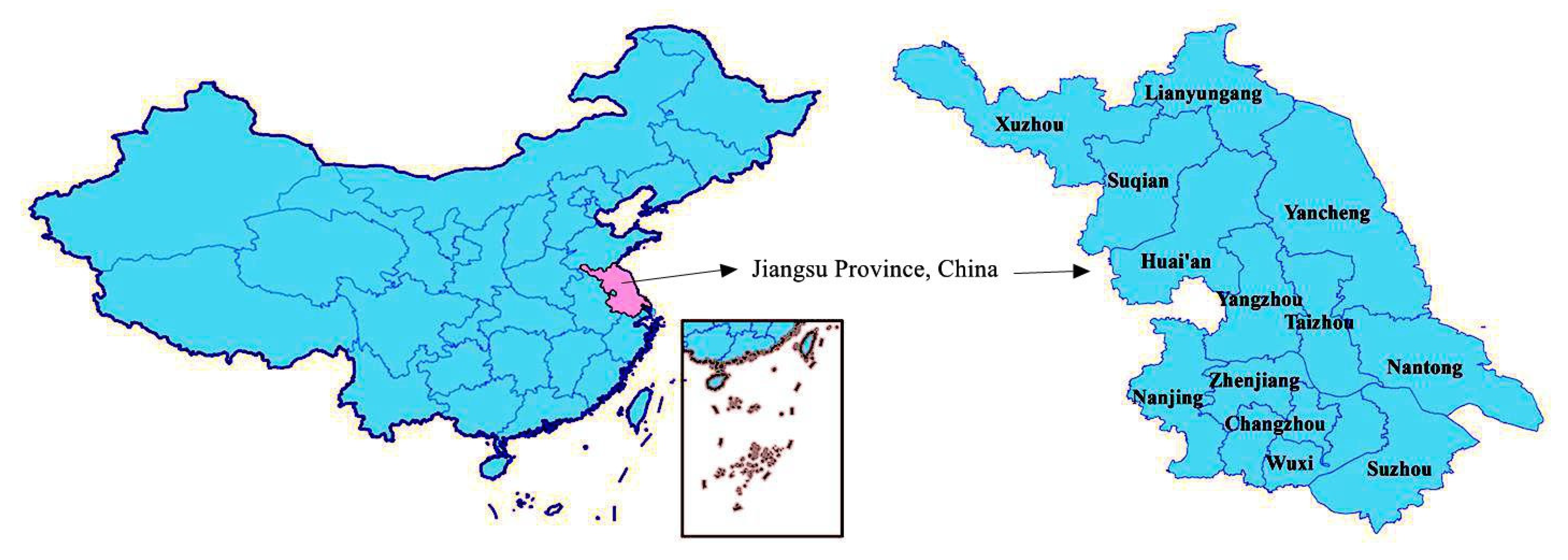
References
- King, A.D.; Lane, T.P.; Henley, B.J.; Brown, J.R. Global and regional impacts differ between transient and equilibrium warmer worlds. Nat. Clim. Chang. 2020, 10, 42–47. [Google Scholar] [CrossRef]
- Krüger, J.J.; Tarach, M. Greenhouse Gas Emission Reduction Potentials in Europe by Sector: A Bootstrap-Based Nonparametric Efficiency Analysis. Environ. Resour. Econ. 2022, 81, 867–898. [Google Scholar] [CrossRef]
- Jensen, H.; Pérez Domínguez, I.; Fellmann, T.; Lirette, P.; Hristov, J.; Philippidis, G. Economic Impacts of a Low Carbon Economy on Global Agriculture: The Bumpy Road to Paris. Sustainability 2019, 11, 2349. [Google Scholar] [CrossRef]
- Liu, M.; Yang, L. Spatial pattern of China’s agricultural carbon emission performance. Ecol. Indic. 2021, 133, 108345. [Google Scholar] [CrossRef]
- He, L.; Wang, B.; Xu, W.; Cui, Q.; Chen, H. Could China’s long-term low-carbon energy transformation achieve the double dividend effect for the economy and environment? Environ. Sci. Pollut. Res. 2022, 29, 20128–20144. [Google Scholar] [CrossRef]
- Zheng, H.; Ma, J.; Yao, Z.; Hu, F. How Does Social Embeddedness Affect Farmers’ Adoption Behavior of Low-Carbon Agricultural Technology? Evidence from Jiangsu Province, China. Front. Environ. Sci. 2022, 10, 909803. [Google Scholar] [CrossRef]
- Xu, T.; Kang, C.; Zhang, H. China’s efforts towards carbon neutrality: Does energy-saving and emission-reduction policy mitigate carbon emissions? J. Environ. Manag. 2022, 316, 115286. [Google Scholar] [CrossRef]
- Wang, S.; Shi, X.; Zhao, Y.; Weindorf, D.C.; Yu, D.; Xu, S.; Tan, M.; Sun, W. Regional Simulation of Soil Organic Carbon Dynamics for Dry Farmland in East China by Coupling a 1:500,000 Soil Database with the Century Model. Pedosphere 2011, 21, 277–287. [Google Scholar] [CrossRef]
- Yang, Y.; Hobbie, S.E.; Hernandez, R.R.; Fargione, J.; Grodsky, S.M.; Tilman, D.; Zhu, Y.; Luo, Y.; Smith, T.M.; Jungers, J.M.; et al. Restoring Abandoned Farmland to Mitigate Climate Change on a Full Earth. One Earth 2020, 3, 176–186. [Google Scholar] [CrossRef]
- Gong, H.; Li, J.; Liu, Z.; Zhang, Y.; Hou, R.; Ouyang, Z. Mitigated Greenhouse Gas Emissions in Cropping Systems by Organic Fertilizer and Tillage Management. Land 2022, 11, 1026. [Google Scholar] [CrossRef]
- Guo, L.; Guo, S.; Tang, M.; Su, M.; Li, H. Financial Support for Agriculture, Chemical Fertilizer Use, and Carbon Emissions from Agricultural Production in China. Int. J. Environ. Res. Public Health 2022, 19, 7155. [Google Scholar] [CrossRef] [PubMed]
- Chen, Y.; Chen, X.; Zheng, P.; Tan, K.; Liu, S.; Chen, S.; Yang, Z.; Wang, X. Value compensation of net carbon sequestration alleviates the trend of abandoned farmland: A quantification of paddy field system in China based on perspectives of grain security and carbon neutrality. Ecol. Indic. 2022, 138, 108815. [Google Scholar] [CrossRef]
- Xue, Y.; Luan, W.; Wang, H.; Yang, Y. Environmental and economic benefits of carbon emission reduction in animal husbandry via the circular economy: A Case study of pig farming in Liaoning, China. J. Clean. Prod. 2019, 238, 117968. [Google Scholar] [CrossRef]
- Zhang, L.; Pang, J.; Chen, X.; Lu, Z. Carbon emissions, energy consumption and economic growth: Evidence from the agricultural sector of China’s main grain-producing areas. Sci. Total Environ. 2019, 665, 1017–1025. [Google Scholar] [CrossRef] [PubMed]
- Huang, X.; Xu, X.; Wang, Q.; Zhang, L.; Gao, X.; Chen, L. Assessment of Agricultural Carbon Emissions and Their Spatiotemporal Changes in China, 1997–2016. Int. J. Environ. Res. Public Health 2019, 16, 3105. [Google Scholar] [CrossRef]
- Wang, G.; Liao, M.; Jiang, J. Research on Agricultural Carbon Emissions and Regional Carbon Emissions Reduction Strategies in China. Sustainability 2020, 12, 2627. [Google Scholar] [CrossRef]
- Huang, H.; Zhou, J. Study on the Spatial and Temporal Differentiation Pattern of Carbon Emission and Carbon Compensation in China’s Provincial Areas. Sustainability 2022, 14, 7627. [Google Scholar] [CrossRef]
- Appiah, K.; Appah, R.; Barnes, W.; Darko, E.A. Testing the validity of disaggregated agricultural-induced growth–environmental pollution nexus in selected emerging economies. Int. J. Environ. Sci. Technol. 2022. [Google Scholar] [CrossRef]
- Wu, Y.; Tam, V.W.Y.; Shuai, C.; Shen, L.; Zhang, Y.; Liao, S. Decoupling China’s economic growth from carbon emissions: Empirical studies from 30 Chinese provinces (2001–2015). Sci. Total Environ. 2019, 656, 576–588. [Google Scholar] [CrossRef]
- Boellstorff, D.L. Estimated soil organic carbon change due to agricultural land management modifications in a semiarid cereal-growing region in Central Spain. J. Arid Environ. 2009, 73, 389–392. [Google Scholar] [CrossRef]
- Li, J.; Wang, W.; Li, M.; Li, Q.; Liu, Z.; Chen, W.; Wang, Y. Impact of Land Management Scale on the Carbon Emissions of the Planting Industry in China. Land 2022, 11, 816. [Google Scholar] [CrossRef]
- Li, Z.; Qi, Z.; Jiang, Q.; Sima, N. An economic analysis software for evaluating best management practices to mitigate greenhouse gas emissions from cropland. Agric. Syst. 2021, 186, 102950. [Google Scholar] [CrossRef]
- Montefrio, M.J.F.; Sonnenfeld, D.A.; Luzadis, V.A. Social construction of the environment and smallholder farmers’ participation in ‘low-carbon’, agro-industrial crop production contracts in the Philippines. Ecol. Econ. 2015, 116, 70–77. [Google Scholar] [CrossRef]
- Haller, A. Influence of Agricultural Chains on the Carbon Footprint in the Context of European Green Pact and Crises. Agriculture 2022, 12, 751. [Google Scholar] [CrossRef]
- Wang, G.; Guo, Q.; Zhou, X.; Zhang, F. Spatial correlation network characteristics of embodied carbon transfer in global agricultural trade. Environ. Sci. Pollut. Res. 2022. [Google Scholar] [CrossRef]
- Wang, R.; Feng, Y. Research on China’s agricultural carbon emission efficiency evaluation and regional differentiation based on DEA and Theil models. Int. J. Environ. Sci. Technol. 2021, 18, 1453–1464. [Google Scholar] [CrossRef]
- Frank, S.; Havlík, P.; Stehfest, E.; van Meijl, H.; Witzke, P.; Pérez-Domínguez, I.; van Dijk, M.; Doelman, J.C.; Fellmann, T.; Koopman, J.F.L.; et al. Agricultural non-CO2 emission reduction potential in the context of the 1.5 °C target. Nat. Clim. Chang. 2019, 9, 66–72. [Google Scholar] [CrossRef]
- Chen, J.; Cheng, S.; Song, M. Changes in energy-related carbon dioxide emissions of the agricultural sector in China from 2005 to 2013. Renew. Sustain. Energy Rev. 2018, 94, 748–761. [Google Scholar] [CrossRef]
- Lin, J.; Lu, S.; He, X.; Wang, F. Analyzing the impact of three-dimensional building structure on CO2 emissions based on random forest regression. Energy 2021, 236, 121502. [Google Scholar] [CrossRef]
- Wei, S.; Wang, Y.; Zhang, C. Forecasting CO2 emissions in Hebei, China, through moth-flame optimization based on the random forest and extreme learning machine. Environ. Sci. Pollut. Res. 2018, 25, 28985–28997. [Google Scholar] [CrossRef]
- Lin, J.; Chen, T.; Han, Q. Simulating and Predicting the Impacts of Light Rail Transit Systems on Urban Land Use by Using Cellular Automata: A Case Study of Dongguan, China. Sustainability 2018, 10, 1293. [Google Scholar] [CrossRef]
- Marçal, M.F.M.; Souza, Z.M.D.; Tavares, R.L.M.; Farhate, C.V.V.; Oliveira, S.R.M.; Galindo, F.S. Predictive Models to Estimate Carbon Stocks in Agroforestry Systems. Forests 2021, 12, 1240. [Google Scholar] [CrossRef]
- Li, T.; Baležentis, T.; Makutėnienė, D.; Streimikiene, D.; Kriščiukaitienė, I. Energy-related CO2 emission in European Union agriculture: Driving forces and possibilities for reduction. Appl. Energy 2016, 180, 682–694. [Google Scholar] [CrossRef]
- Okorie, D.I.; Lin, B. Emissions in agricultural-based developing economies: A case of Nigeria. J. Clean. Prod. 2022, 337, 130570. [Google Scholar] [CrossRef]
- Li, W.; Ou, Q.; Chen, Y. Decomposition of China’s CO2 emissions from agriculture utilizing an improved Kaya identity. Environ. Sci. Pollut. Res. 2014, 21, 13000–13006. [Google Scholar] [CrossRef]
- Akram, Z.; Engo, J.; Akram, U.; Zafar, M.W. Identification and analysis of driving factors of CO2 emissions from economic growth in Pakistan. Environ. Sci. Pollut. Res. 2019, 26, 19481–19489. [Google Scholar] [CrossRef]
- Huang, W.; Wu, F.; Han, W.; Li, Q.; Han, Y.; Wang, G.; Feng, L.; Li, X.; Yang, B.; Lei, Y.; et al. Carbon footprint of cotton production in China: Composition, spatiotemporal changes and driving factors. Sci. Total Environ. 2022, 821, 153407. [Google Scholar] [CrossRef]
- Tian, Y.; Ruth, M.; Zhu, D. Using the IPAT identity and decoupling analysis to estimate water footprint variations for five major food crops in China from 1978 to 2010. Environ. Dev. Sustain. 2017, 19, 2355–2375. [Google Scholar] [CrossRef]
- Xu, G.; Li, J.; Schwarz, P.M.; Yang, H.; Chang, H. Rural financial development and achieving an agricultural carbon emissions peak: An empirical analysis of Henan Province, China. Environ. Dev. Sustain. 2022. [Google Scholar] [CrossRef]
- Aziz, S.; Chowdhury, S.A. Analysis of agricultural greenhouse gas emissions using the STIRPAT model: A case study of Bangladesh. Environ. Dev. Sustain. 2022. [Google Scholar] [CrossRef]
- Arshed, N.; Munir, M.; Iqbal, M. Sustainability assessment using STIRPAT approach to environmental quality: An extended panel data analysis. Environ. Sci. Pollut. Res. Int. 2021, 28, 18163–18175. [Google Scholar] [CrossRef] [PubMed]
- Wang, Z.; Huang, L.; Yin, L.; Wang, Z.; Zheng, D. Evaluation of Sustainable and Analysis of Influencing Factors for Agriculture Sector: Evidence from Jiangsu Province, China. Front. Environ. Sci. 2022, 10, 836002. [Google Scholar] [CrossRef]
- Zhou, P.; Li, H. Carbon Emissions from Manufacturing Sector in Jiangsu Province: Regional Differences and Decomposition of Driving Factors. Sustainability 2022, 14, 9123. [Google Scholar] [CrossRef]
- Rehman, A.; Ma, H.; Irfan, M.; Ahmad, M. Does carbon dioxide, methane, nitrous oxide, and GHG emissions influence the agriculture? Evidence from China. Environ. Sci. Pollut. Res. 2020, 27, 28768–28779. [Google Scholar] [CrossRef] [PubMed]
- Lu, X.; Kuang, B.; Li, J.; Han, J.; Zhang, Z. Dynamic Evolution of Regional Discrepancies in Carbon Emissions from Agricultural Land Utilization: Evidence from Chinese Provincial Data. Sustainability 2018, 10, 552. [Google Scholar] [CrossRef]
- Smakgahn, K. Effect of rice straw incorporation on methane emission and rice yields from rice cropping system by DNDC-Rice model. Int. J. Glob. Warm. 2018, 16, 55–62. [Google Scholar] [CrossRef]
- Ayyildiz, M.; Erdal, G. The relationship between carbon dioxide emission and crop and livestock production indexes: A dynamic common correlated effects approach. Environ. Sci. Pollut. Res. 2021, 28, 597–610. [Google Scholar] [CrossRef]
- Billen, G.; Garnier, J.; Grossel, A.; Thieu, V.; Théry, S.; Hénault, C. Modeling indirect N2O emissions along the N cascade from cropland soils to rivers. Biogeochemistry 2020, 148, 207–221. [Google Scholar] [CrossRef]
- Huang, Y.; Su, Y.; Li, R.; He, H.; Liu, H.; Li, F.; Shu, Q. Study of the Spatio-Temporal Differentiation of Factors Influencing Carbon Emission of the Planting Industry in Arid and Vulnerable Areas in Northwest China. Int. J. Environ. Res. Public Health 2020, 17, 187. [Google Scholar] [CrossRef]
- Duan, H.P.; Zhang, Y.; Zhao, J.B.; Bian, X.M. Carbon footprint analysis of China’s farmland ecosystem. J. Soil Water Conserv. 2011, 5, 203–208. [Google Scholar] [CrossRef]
- Wu, F.L.; Li, L.; Zhang, H.L. Effect of conservation tillage on net carbon release of farmland ecosystem in Fuchen. Ecology 2007, 12, 2035–2039. (In Chinese) [Google Scholar]
- Liu, N.D.; Hu, H.; Hu, Z.Y. Research on the structural characteristics and influencing factors of carbon emissions from rice production in Jiangsu Province—From the perspective of farmers’ production input and scale. Anhui Agric. Sci. 2014, 42, 4121–4124. [Google Scholar] [CrossRef]
- Darand, M.; Dostkamyan, M.; Rehmani, M.I.A. Spatial autocorrelation analysis of extreme precipitation in Iran. Russ. Meteorol. Hydrol. 2017, 42, 415–424. [Google Scholar] [CrossRef]
- Chen, K.; Liu, X.; Ding, L.; Huang, G.; Li, Z. Spatial Characteristics and Driving Factors of Provincial Wastewater Discharge in China. Int. J. Environ. Res. Public Health 2016, 13, 1221. [Google Scholar] [CrossRef]
- Xu, W.; Tian, Y.; Liu, Y.; Zhao, B.; Liu, Y.; Zhang, X. Understanding the Spatial-Temporal Patterns and Influential Factors on Air Quality Index: The Case of North China. Int. J. Environ. Res. Public Health 2019, 16, 2820. [Google Scholar] [CrossRef]
- Singh, M.K.; Mukherjee, D. Drivers of greenhouse gas emissions in the United States: Revisiting STIRPAT model. Environ. Dev. Sustain. 2019, 21, 3015–3031. [Google Scholar] [CrossRef]
- Nasrollahi, Z.; Hashemi, M.; Bameri, S.; Mohamad Taghvaee, V. Environmental pollution, economic growth, population, industrialization, and technology in weak and strong sustainability: Using STIRPAT model. Environ. Dev. Sustain. 2020, 22, 1105–1122. [Google Scholar] [CrossRef]
- Shahbaz, M.; Loganathan, N.; Muzaffar, A.T.; Ahmed, K.; Ali Jabran, M. How does urbanization affects CO2 emissions in Malaysia? The application of STIRPAT model. Renew. Sustain. Energy Rev. 2016, 57, 83–93. [Google Scholar] [CrossRef]
- Ma, L.; Zhang, W.; Wu, S.; Shi, Z. Research on the Impact of Rural Population Structure Changes on the Net Carbon Sink of Agricultural Production-Take Huan County in the Loess Hilly Region of China as an Example. Front. Environ. Sci. 2022, 10, 911403. [Google Scholar] [CrossRef]
- Sui, J.; Lv, W. Crop Production and Agricultural Carbon Emissions: Relationship Diagnosis and Decomposition Analysis. Int. J. Environ. Res. Public Health 2021, 18, 8219. [Google Scholar] [CrossRef]
- Zhong, R.; He, Q.; Qi, Y. Digital Economy, Agricultural Technological Progress, and Agricultural Carbon Intensity: Evidence from China. Int. J. Environ. Res. Public Health 2022, 19, 6488. [Google Scholar] [CrossRef] [PubMed]
- Chen, Y.; Li, M.; Su, K.; Li, X. Spatial-Temporal Characteristics of the Driving Factors of Agricultural Carbon Emissions: Empirical Evidence from Fujian, China. Energies 2019, 12, 3102. [Google Scholar] [CrossRef]
- Adebayo, T.S.; Akinsola, G.D.; Kirikkaleli, D.; Bekun, F.V.; Umarbeyli, S.; Osemeahon, O.S. Economic performance of Indonesia amidst CO2 emissions and agriculture: A time series analysis. Environ. Sci. Pollut. Res. 2021, 28, 47942–47956. [Google Scholar] [CrossRef] [PubMed]
- Khatri-Chhetri, A.; Sapkota, T.B.; Sander, B.O.; Arango, J.; Nelson, K.M.; Wilkes, A. Financing climate change mitigation in agriculture: Assessment of investment cases. Environ. Res. Lett. 2021, 16, 124044. [Google Scholar] [CrossRef]
- Jin, X.; Li, Y.; Sun, D.; Zhang, J.; Zheng, J. Factors Controlling Urban and Rural Indirect Carbon Dioxide Emissions in Household Consumption: A Case Study in Beijing. Sustainability 2019, 11, 6563. [Google Scholar] [CrossRef]
- Zhang, Y.X. Research on ecological environmental protection and utilization of water resource—Investigation and data analysis on ecological practice of five villages in Jiangsu, Jiangxi, Hubei, Hunan and Gansu. J. Coast. Res. 2020, 115, 522. [Google Scholar] [CrossRef]
- Zhao, Z.; Cheng, H.; Wang, S.; Liu, H.; Song, Z.; Zhou, J.; Pang, J.; Bai, S.; Yang, S.; Ding, J.; et al. SCC-UEFAS, an urban-ecological-feature based assessment system for sponge city construction. Environ. Sci. Ecotechnol. 2022, 12, 100188. [Google Scholar] [CrossRef]
- Liu, J.; Luo, M.; Chen, Z.; Gou, J.; Yan, Z. The effects of terrain factors on the drainage area threshold: Comparison of principal component analysis and correlation analysis. Environ. Monit. Assess. 2022, 194, 168. [Google Scholar] [CrossRef]
- Melkamu Asaye, M.; Gelaye, K.A.; Matebe, Y.H.; Lindgren, H.; Erlandsson, K. Valid and reliable neonatal near-miss assessment scale in Ethiopia: A psychometric validation. Glob. Health Action 2022, 15, 2029334. [Google Scholar] [CrossRef]

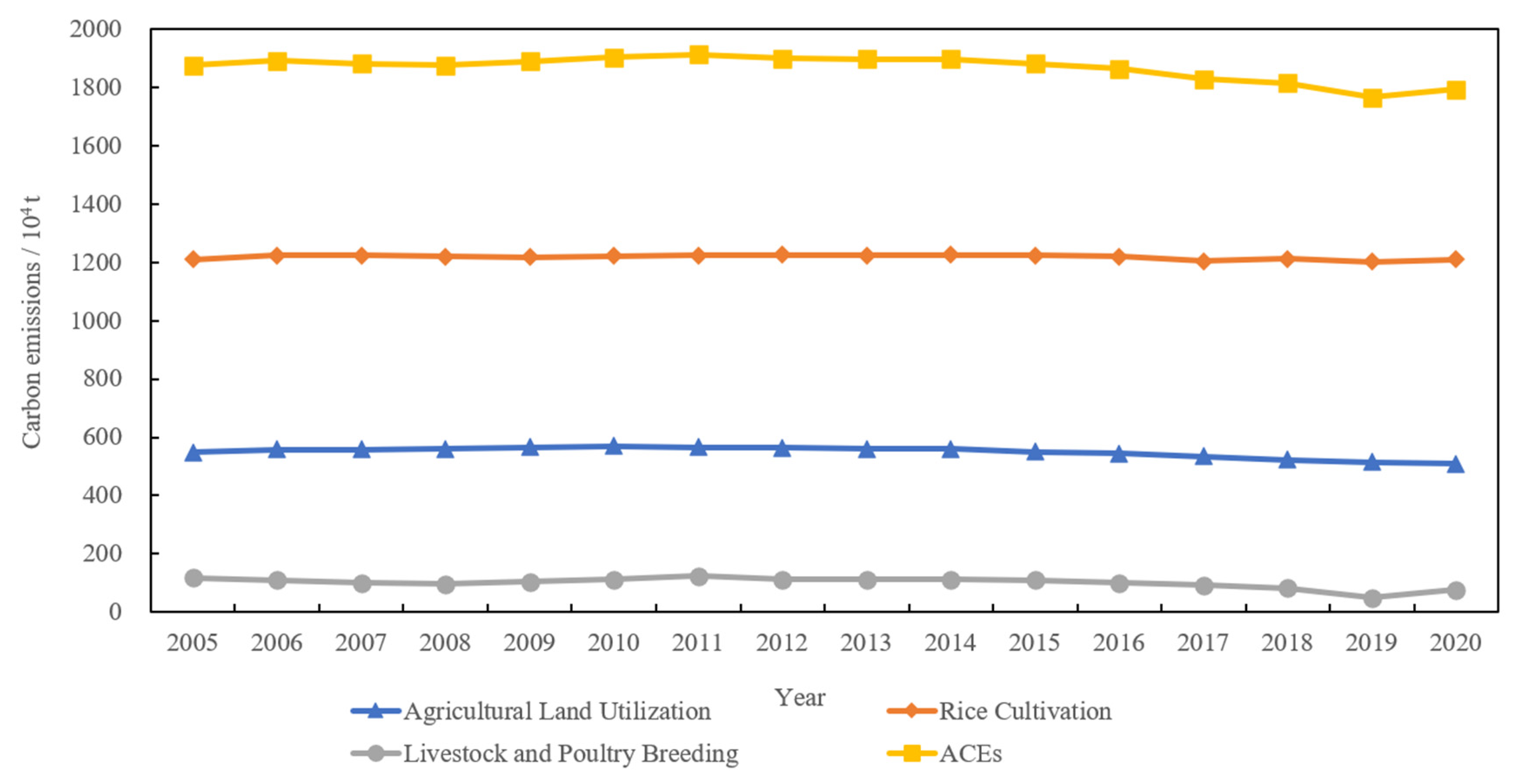
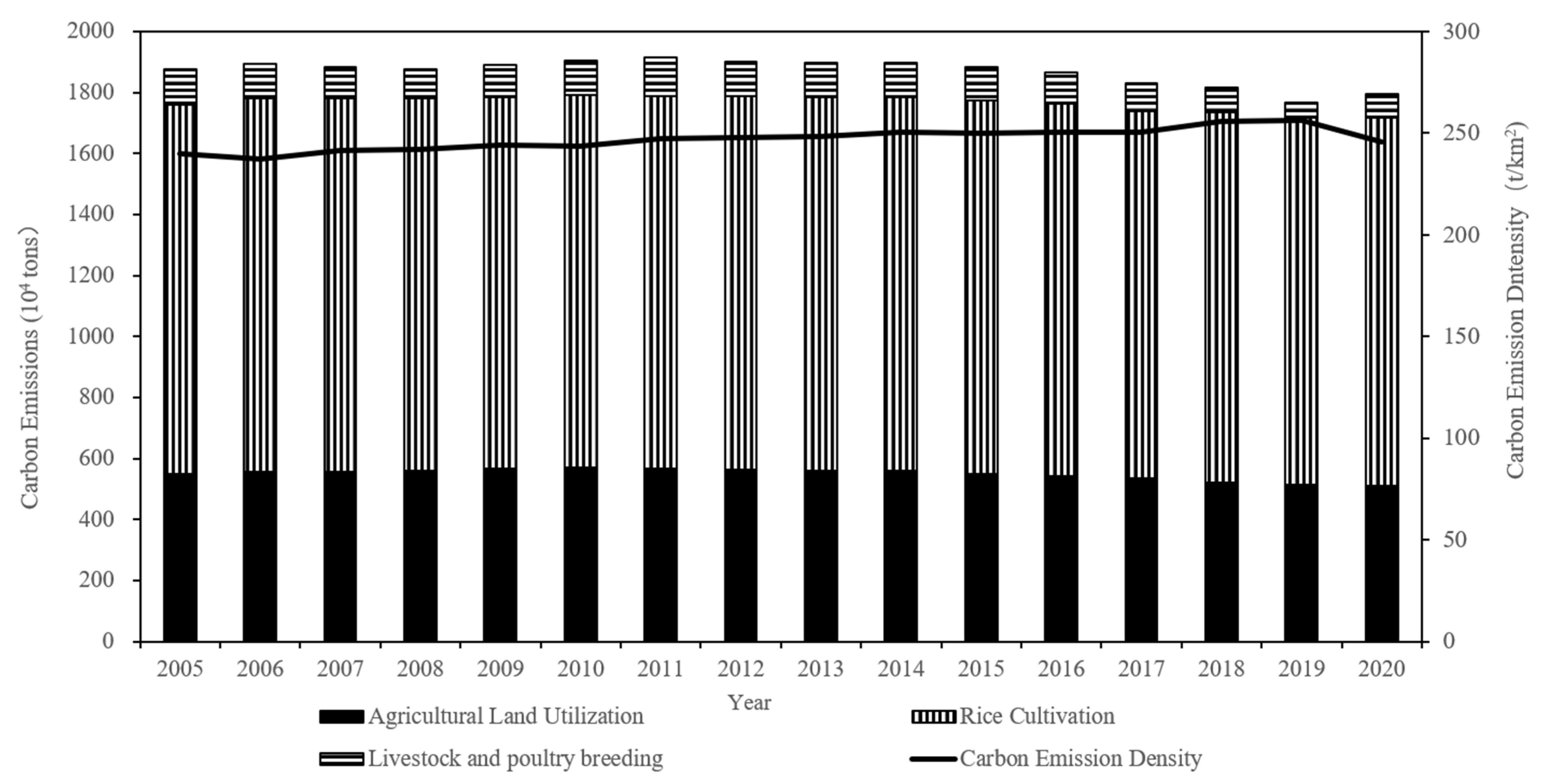
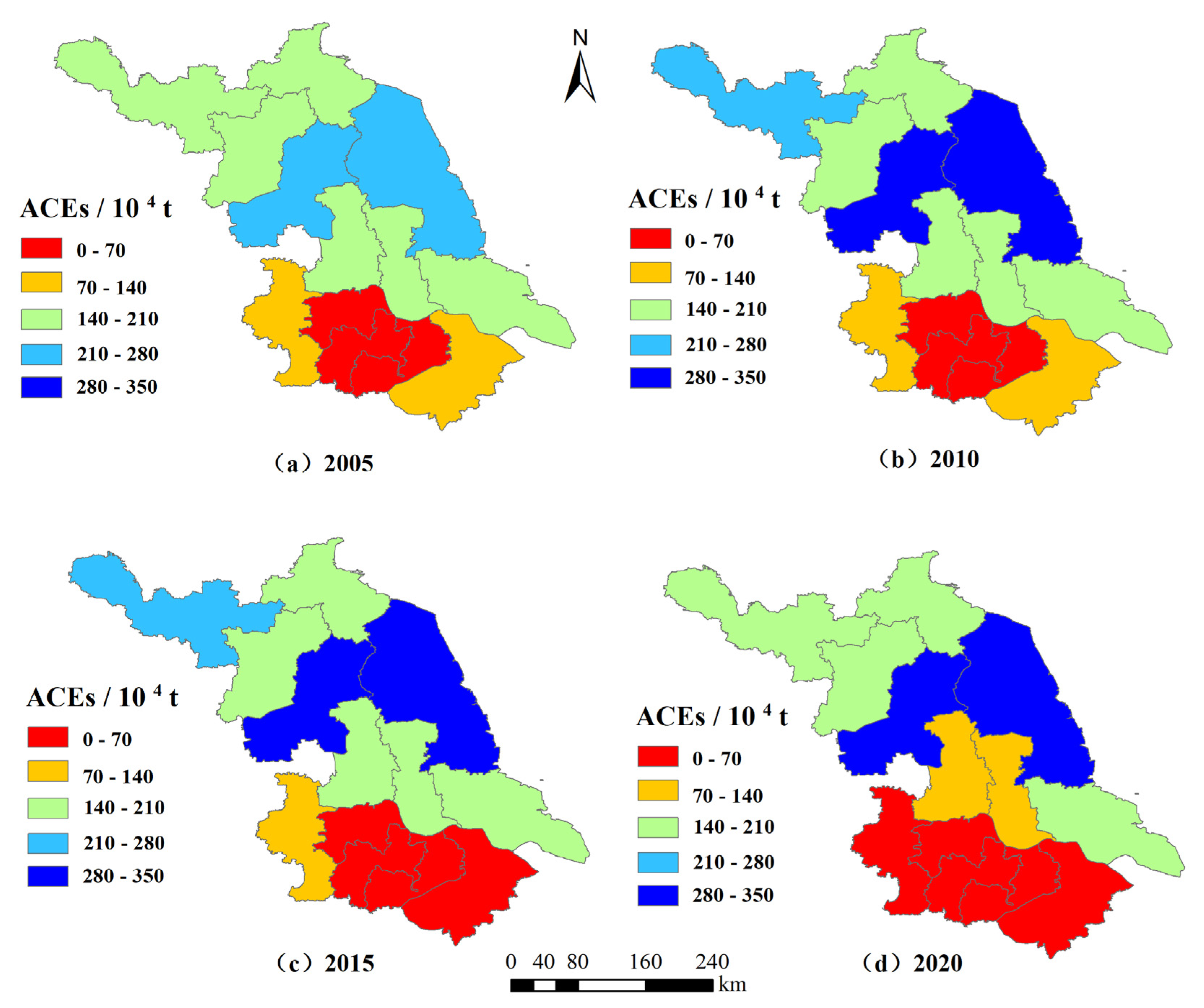

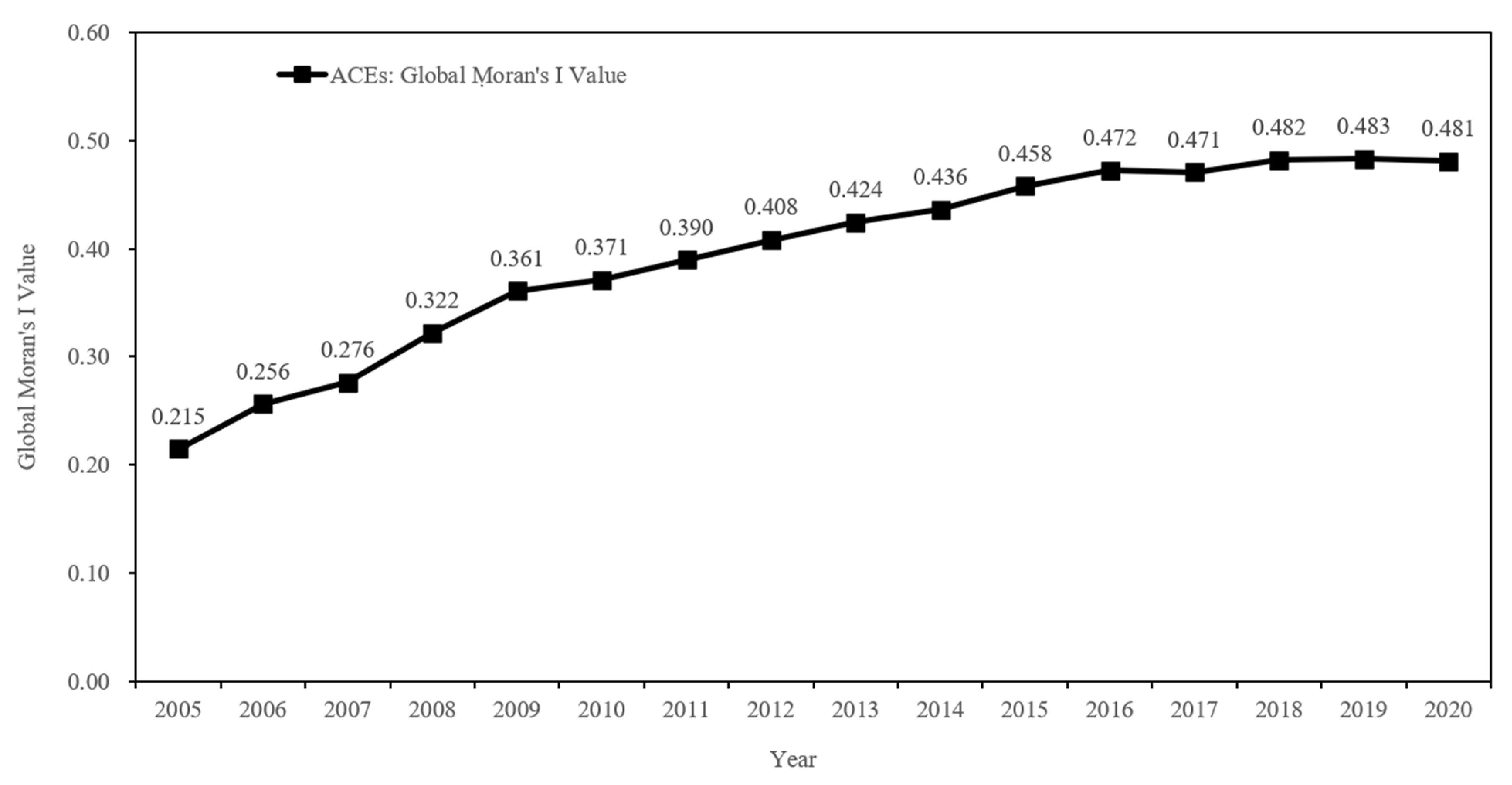
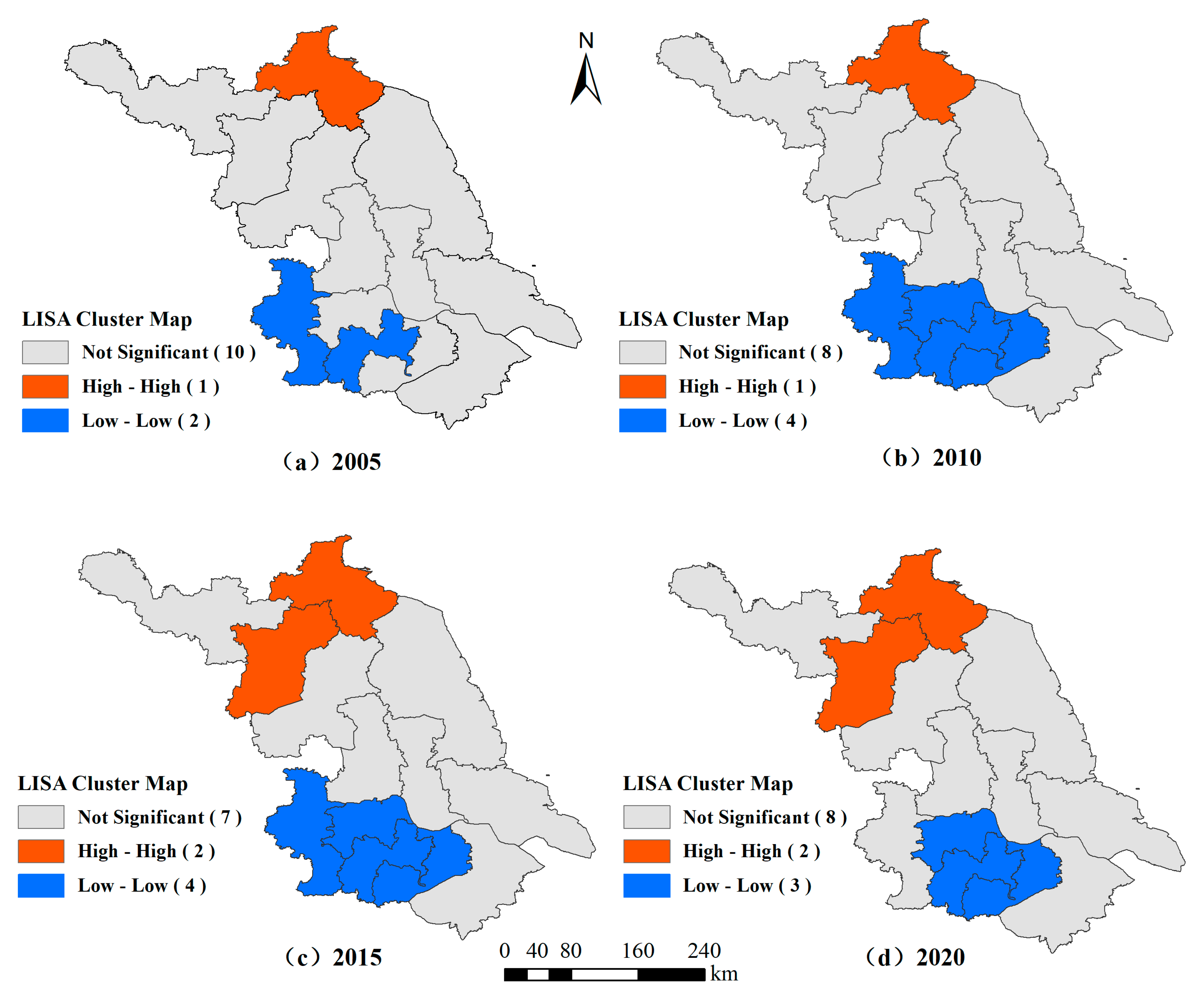
| Variable | Mean | SD | Min | Max |
|---|---|---|---|---|
| ACEs/(104t) | 1868.17 | 43.08 | 1766.69 | 1913.94 |
| ACED/(t/km2) | 246.93 | 5.35 | 237.38 | 256.34 |
| Urbanization rate/(%) | 62.81 | 7.72 | 50.50 | 73.40 |
| Rural population/(104) | 2988.41 | 502.49 | 2251.40 | 3756.18 |
| Total agricultural output/(108 CNY) | 5470.46 | 1866.34 | 2576.98 | 7952.59 |
| Disposable income per rural resident/(CNY) | 13,376.75 | 6243.85 | 5258.00 | 24,198.00 |
| Total power of agricultural machinery/(104 kw) | 4290.88 | 701.84 | 3135.33 | 5214.83 |
| Total fixed asset investment in agriculture/(108 CNY) | 311.81 | 198.52 | 54.79 | 608.99 |
| Share of output value of farming and animal husbandry/(%) | 71.19 | 2.47 | 67.10 | 74.22 |
| Carbon Category | Carbon Source | Coefficient | Unit | Refer Source |
|---|---|---|---|---|
| Agricultural land utilization | Pesticide | 4.934 | Kg C/Kg | ORN |
| Agricultural plastic films | 5.180 | Kg C/Kg | IREEA | |
| Fertilizer | 0.896 | Kg C/Kg | OPNL | |
| Agricultural diesel oil | 0.593 | Kg C/Kg | IPCC (2007) | |
| Agricultural irrigation | 266.480 | Kg C/Hm2 | Duan et al. [50] | |
| Agricultural cultivation | 312.600 | Kg C/Km2 | Wu et al. [51] | |
| Rice cultivation | Rice | 5110.92 | Kg C/Hm2 | Liu et al. [52] |
| Livestock breeding emissions | Cattle | 415.91 | Kg C/Year | IPCC (2007) |
| Sheep | 35.182 | Kg C/Year | IPCC (2007) | |
| Pigs | 34.091 | Kg C/Year | IPCC (2007) |
| Year | Agricultural Land Utilization | Rice Cultivation | Livestock and Poultry Breeding | ACE /104 t | Growth Rate /% | ACED (t/km2) | |||
|---|---|---|---|---|---|---|---|---|---|
| CE /104 t | PERC /% | CE /104 t | PERC /% | CE /104 t | PERC /% | ||||
| 2005 | 548.45 | 29.21 | 1210.76 | 64.49 | 118.36 | 6.30 | 1877.57 | - | 240.06 |
| 2006 | 557.97 | 29.47 | 1224.50 | 64.68 | 110.68 | 5.85 | 1893.15 | 0.83 | 237.38 |
| 2007 | 557.45 | 29.61 | 1224.47 | 65.03 | 100.88 | 5.36 | 1882.80 | −0.55 | 241.38 |
| 2008 | 559.82 | 29.83 | 1220.78 | 65.05 | 96.19 | 5.13 | 1876.80 | −0.32 | 242.17 |
| 2009 | 566.29 | 29.96 | 1219.13 | 64.50 | 104.80 | 5.54 | 1890.23 | 0.72 | 244.07 |
| 2010 | 569.60 | 29.93 | 1221.50 | 64.17 | 112.34 | 5.90 | 1903.44 | 0.70 | 243.44 |
| 2011 | 566.50 | 29.60 | 1223.32 | 63.92 | 124.12 | 6.49 | 1913.94 | 0.55 | 247.25 |
| 2012 | 563.23 | 29.62 | 1225.63 | 64.46 | 112.45 | 5.91 | 1901.31 | −0.66 | 247.69 |
| 2013 | 560.10 | 29.52 | 1224.89 | 64.55 | 112.54 | 5.93 | 1897.52 | −0.20 | 248.49 |
| 2014 | 559.31 | 29.46 | 1227.02 | 64.63 | 112.23 | 5.91 | 1898.57 | 0.06 | 250.31 |
| 2015 | 549.84 | 29.19 | 1223.61 | 64.96 | 110.20 | 5.85 | 1883.64 | −0.79 | 249.89 |
| 2016 | 543.69 | 29.16 | 1220.42 | 65.45 | 100.56 | 5.39 | 1864.67 | −1.01 | 250.61 |
| 2017 | 534.01 | 29.18 | 1203.75 | 65.78 | 92.20 | 5.04 | 1829.95 | −1.86 | 250.41 |
| 2018 | 522.04 | 28.76 | 1211.59 | 66.75 | 81.62 | 4.50 | 1815.25 | −0.80 | 255.72 |
| 2019 | 515.19 | 29.16 | 1203.42 | 68.12 | 48.08 | 2.72 | 1766.69 | −2.68 | 256.34 |
| 2020 | 508.73 | 28.34 | 1210.19 | 67.41 | 76.32 | 4.25 | 1795.24 | 1.62 | 245.72 |
| AAGR/% | −0.50 | − | 0.00 | − | −2.88 | − | −0.30 | 0.16 | |
| City | 2005 | 2010 | 2015 | 2020 | ||||
|---|---|---|---|---|---|---|---|---|
| ACEs (104 t) | ACED (t/km2) | ACEs (104 t) | ACED (t/km2) | ACEs (104 t) | ACED (t/km2) | ACEs (104 t) | ACED (t/km2) | |
| Nanjing | 96.87 | 241.42 | 79.53 | 237.21 | 76.91 | 242.70 | 66.41 | 264.09 |
| Wuxi | 63.46 | 339.34 | 51.54 | 284.90 | 39.87 | 230.28 | 31.52 | 242.86 |
| Xuzhou | 204.74 | 199.80 | 215.39 | 195.97 | 211.89 | 182.56 | 189.85 | 160.83 |
| Changzhou | 68.77 | 285.49 | 62.36 | 269.92 | 57.48 | 267.79 | 42.45 | 257.19 |
| Suzhou | 74.53 | 239.79 | 71.64 | 265.43 | 63.87 | 255.27 | 54.93 | 262.01 |
| Nantong | 164.71 | 188.72 | 158.63 | 185.54 | 152.15 | 182.05 | 146.41 | 186.20 |
| Lianyungang | 150.06 | 270.43 | 163.77 | 276.69 | 166.89 | 263.34 | 166.69 | 263.33 |
| Huai’an | 266.37 | 358.62 | 282.81 | 362.79 | 290.69 | 365.34 | 299.56 | 369.92 |
| Yancheng | 270.85 | 198.78 | 297.66 | 203.86 | 303.53 | 212.73 | 307.06 | 221.02 |
| Zhenjiang | 68.03 | 291.41 | 62.99 | 264.34 | 60.73 | 257.34 | 49.55 | 273.81 |
| Taizhou | 148.38 | 264.54 | 142.99 | 249.99 | 140.34 | 241.54 | 129.18 | 249.10 |
| Suqian | 159.37 | 238.62 | 170.08 | 241.60 | 173.58 | 243.80 | 174.94 | 234.40 |
| Yangzhou | 141.44 | 301.80 | 144.05 | 288.02 | 145.72 | 286.21 | 136.69 | 286.06 |
| Year | ACEs | Z-Value | p-Value | ACED | Z-Value | p-Value |
|---|---|---|---|---|---|---|
| 2005 | 0.215 | 1.871 | 0.049 | 0.023 | 0.579 | 0.256 |
| 2006 | 0.256 | 2.105 | 0.033 | −0.010 | 0.411 | 0.305 |
| 2007 | 0.276 | 2.216 | 0.025 | −0.015 | 0.408 | 0.323 |
| 2008 | 0.322 | 2.448 | 0.022 | −0.006 | 0.446 | 0.302 |
| 2009 | 0.361 | 2.673 | 0.012 | −0.022 | 0.362 | 0.335 |
| 2010 | 0.371 | 2.720 | 0.010 | −0.026 | 0.344 | 0.354 |
| 2011 | 0.390 | 2.847 | 0.012 | −0.008 | 0.462 | 0.318 |
| 2012 | 0.408 | 2.912 | 0.009 | −0.014 | 0.433 | 0.336 |
| 2013 | 0.424 | 3.044 | 0.007 | −0.002 | 0.496 | 0.307 |
| 2014 | 0.436 | 3.066 | 0.005 | 0.008 | 0.571 | 0.283 |
| 2015 | 0.458 | 3.104 | 0.004 | 0.009 | 0.589 | 0.276 |
| 2016 | 0.472 | 3.254 | 0.004 | 0.027 | 0.677 | 0.267 |
| 2017 | 0.471 | 3.245 | 0.003 | 0.059 | 0.888 | 0.195 |
| 2018 | 0.482 | 3.270 | 0.005 | 0.045 | 0.793 | 0.228 |
| 2019 | 0.483 | 3.248 | 0.003 | 0.015 | 0.593 | 0.281 |
| 2020 | 0.481 | 3.149 | 0.004 | 0.308 | 0.683 | 0.249 |
| Factors | Initial Eigenvalues | Extraction Sums of Squared Loadings | ||||
|---|---|---|---|---|---|---|
| Total | % of Variance | Cumulative % | Total | % of Variance | Cumulative % | |
| 1 | 6.146 | 87.805 | 87.805 | 6.146 | 87.805 | 87.805 |
| 2 | 0.765 | 10.930 | 98.735 | 0.765 | 10.930 | 98.735 |
| 3 | 0.056 | 0.802 | 99.537 | |||
| 4 | 0.021 | 0.299 | 99.837 | |||
| 5 | 0.009 | 0.132 | 99.969 | |||
| 6 | 0.001 | 0.020 | 99.989 | |||
| 7 | 0.001 | 0.011 | 100.000 | |||
| Variable | Factors | |
|---|---|---|
| FAC1 | FAC2 | |
| InP | −0.176 | 0.023 |
| InA | 0.197 | −0.089 |
| InT | 0.182 | −0.038 |
| InV | −0.263 | 1.088 |
| InU | 0.174 | −0.011 |
| InC | 0.179 | −0.031 |
| InR | 0.192 | −0.069 |
| Parameter | Unnormalized Coefficient | Standardization Coefficient | t-Test | p-Value | |
|---|---|---|---|---|---|
| Nonstandard Coefficient | SE | Beta | |||
| Constant | 0.000 | 0.208 | 0.000 | 0.000 | 1.000 |
| FAC1 | −0.632 | 0.215 | −0.632 | −2.944 | 0.011 |
| FAC2 | 0.024 | 0.215 | 0.024 | 0.113 | 0.412 |
Publisher’s Note: MDPI stays neutral with regard to jurisdictional claims in published maps and institutional affiliations. |
© 2022 by the authors. Licensee MDPI, Basel, Switzerland. This article is an open access article distributed under the terms and conditions of the Creative Commons Attribution (CC BY) license (https://creativecommons.org/licenses/by/4.0/).
Share and Cite
Hu, C.; Fan, J.; Chen, J. Spatial and Temporal Characteristics and Drivers of Agricultural Carbon Emissions in Jiangsu Province, China. Int. J. Environ. Res. Public Health 2022, 19, 12463. https://doi.org/10.3390/ijerph191912463
Hu C, Fan J, Chen J. Spatial and Temporal Characteristics and Drivers of Agricultural Carbon Emissions in Jiangsu Province, China. International Journal of Environmental Research and Public Health. 2022; 19(19):12463. https://doi.org/10.3390/ijerph191912463
Chicago/Turabian StyleHu, Chao, Jin Fan, and Jian Chen. 2022. "Spatial and Temporal Characteristics and Drivers of Agricultural Carbon Emissions in Jiangsu Province, China" International Journal of Environmental Research and Public Health 19, no. 19: 12463. https://doi.org/10.3390/ijerph191912463
APA StyleHu, C., Fan, J., & Chen, J. (2022). Spatial and Temporal Characteristics and Drivers of Agricultural Carbon Emissions in Jiangsu Province, China. International Journal of Environmental Research and Public Health, 19(19), 12463. https://doi.org/10.3390/ijerph191912463






